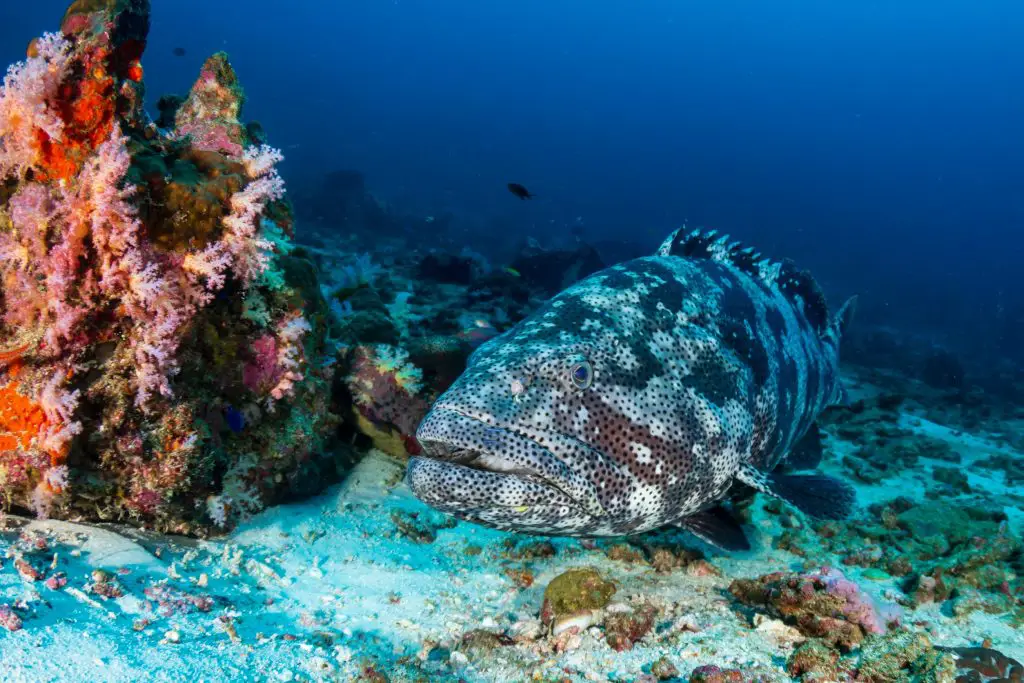Grouper make small, short movements with their bodies because they’re not suitable for speed and long-distance swimming, unlike other classes of fish like smaller predators or large pelagic prey. Other reasons they swim slowly include the size of their body and the shape of their back which pushes them down while they swim.
In the marine world, there are a few animals that are not the most active when it comes to movement. One example is Grouper fish, considered “slow swimmers” due to their large bodies and shape. That said, they’re not too quick or divers, either.

Fish Movement
Fish typically swim in a straight line, but they can move in all directions depending on the location and circumstances. They use their tails to control their movement and generate thrust. Fish also use their fins to create waves that help them move through the water more quickly or to change direction.
Grouper Movement
The Grouper is a type of fish that moves slowly through the water. They can move their bodies quickly from side to side or forward and backward when needed. This is how they move around in their environment and get food. Grouper move in a variety of ways depending on the situation. Some groupers move through the water by swimming with their body parallel to the direction of the current. Others twist and turn their bodies to move through tight spaces. Grouper also use their bodies to push objects out of their way or to capture prey.
Groupers are an exciting fish to watch in the wild. They can move slowly and agilely through the water, using their bodies to propel themselves forward. They can also change the direction of their fins quickly. This flexibility helps grouper move quickly through the water, avoiding predators or prey. They have torpedo-shaped bodies and can swim through the water at high speeds. Grouper use their fins to move through the water quickly. However, their movement depends on their size as well.
How Does a Grouper Move in Water?
Grouper move in various ways, depending on their habitat and hunting strategy. Some groupers use lateral movements to evade predators or change positions to find prey. Others swim by making tight circles. Still, others use their tails to generate thrust.
Groupers are a type of fish that live in warm, tropical waters. They have large heads and jaws that allow them to capture prey easily. Grouper also has a large, fan-shaped tail that they can use to swim quickly. They use their fins and tails to move through the water. Their fins help them move through the water faster and keep them stable. Their tails help them move through the water more easily and control their movement. Grouper use their heads to sense their surroundings, feed, and defend themselves from predators. They use their bodies to move in different directions and attack prey.
The Swimming Method of a Grouper
Grouper fish move by swimming. Grouper fish swim in a circular motion with their dorsal and anal fins outstretched. They use their pectoral fins to control their movement. Groupers are usually found in deep water and are known to be very slow and steady swimmers. They use the slow swimming method” to navigate their way around. Grouper fish will start swimming slowly and then gradually increase their speed until they reach their cruising speed. This method allows them to quickly cover a large area and track potential threats. Groupers are large, slow-moving fish that live in deep water. They use their large mouths to capture prey by suction. Groupers swim by moving their entire body in unison, which makes them difficult to catch with a net.
Why do Grouper move?
The Grouper is a type of fish that migrate to find food. They swim in large groups to find the best feeding areas. When they find an area with good food sources, they will stay there until they are ready to move on. Grouper move for a variety of reasons, but mainly to find food. Grouper has a wide range of hunting methods, from ambush to stalking prey.
They use their eyes to locate food and navigate their environment. The eyes have a high level of sensitivity and allow the grouper to see in low light conditions and at great distances. Grouper also use their eyes to detect changes in the water, such as an impending attack from another fish.
How Fast Can They Swim?
Grouper is not as fast as some of their speedier cousins, but they can still outrun most people if they are smaller. They use their strong tails to help them move through the water and their large mouths to snatch prey. The grouper fish is generally large and heavy. Grouper fish come in different varieties and weights. Among the most famous and largest groupers is the Goliath Grouper. The size of a Goliath can reach 8.2 feet, and its weight can reach 1000 pounds. A Grouper weighs approximately 400-500 pounds on average. In addition to being slow, groupers are also solitary creatures. Due to their slow speed, they are easy to catch.
How do Grouper Swim in Ocean?
They have a unique way of swimming that is pretty strange, but it works well for them. Grouper fish swim using their dorsal fins to push themselves through the water. This method is different than most other fish because they use their fins to move them forward rather than to help them swim backward.
The grouper fish is a large saltwater fish found in the Gulf of Mexico and the Caribbean. Grouper are considered medium-sized fish but can reach lengths of up to 10 feet. They like to eat crustaceans and other small fish.
What Factors Influence Grouper Speed?
One of the most important factors is the size and shape of the grouper. Groupers are larger and have a more streamlined body move slower than those that are smaller or have a more oblong shape. Another critical factor is the Grouper’s weight. Grouper which are heavier tend to move slower than those that are lighter. Finally, grouper speed is also influenced by how deep they are swimming. Grouper that are swimming deeper move slower due to their bottom-feeding habit.
Conclusion
Grouper move in a specific direction by contracting a heavy body, which causes them to tug on their anchor point. This movement propels them forward. Additionally, grouper can change direction quickly by using its fins. This ability to change direction responds to disturbances in the water, such as predators or prey. Grouper is an interesting fish, and their movement is no exception.











